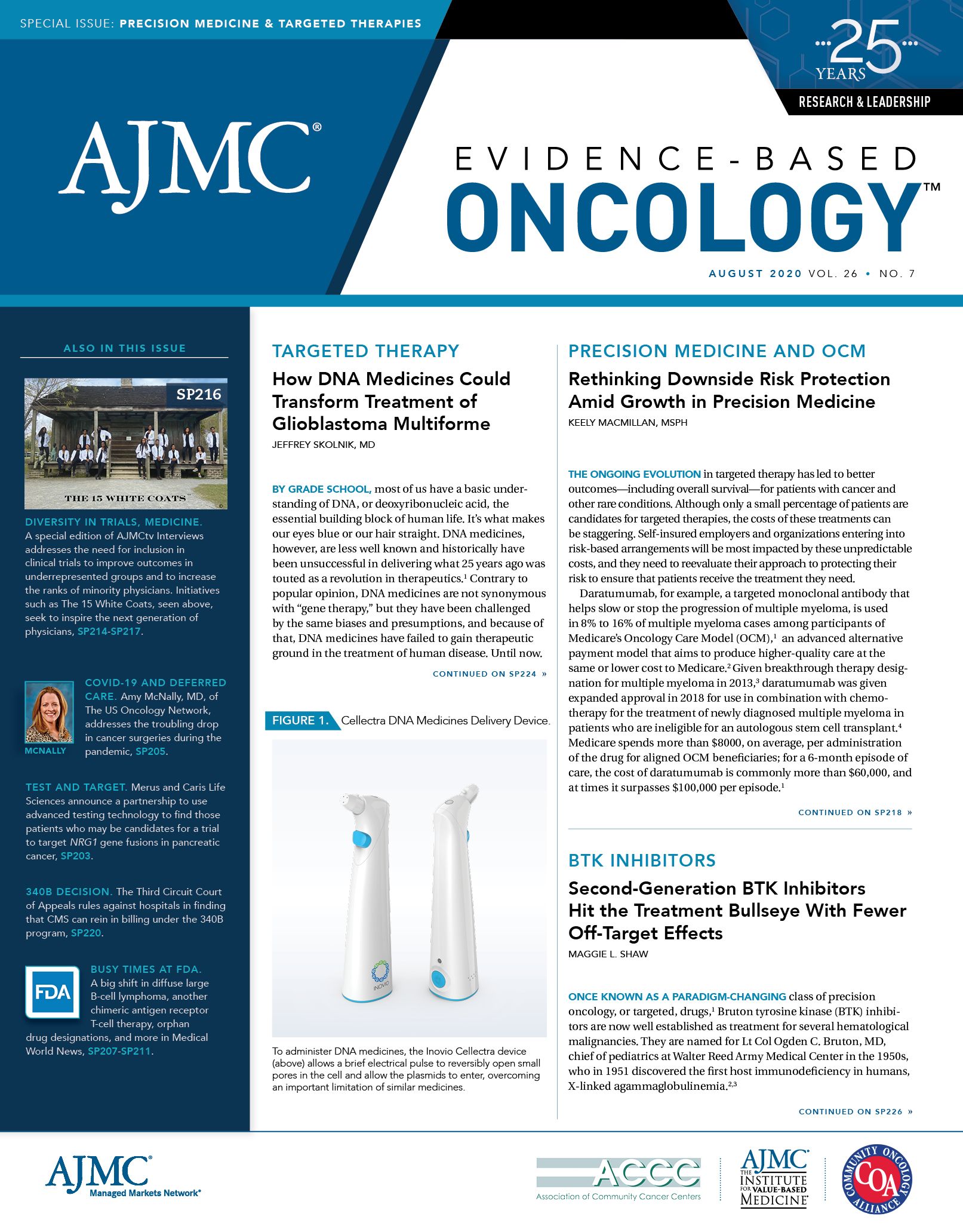Publication
Article
Evidence-Based Oncology
Sidebar: CMS Seeks to Fix Medicaid Best-Price Barriers in Value-Based Contracting for High-Cost Therapies in Medicaid
Author(s):
Proposed CMS rules would make it easier for state Medicaid programs to smooth the way for value-based contracts for high-cost gene therapies.
https://doi.org/10.37765/ajmc.2020.88474
In June, CMS propsoed long-awaited reforms to allow flexibility for value-based contracting in Medicaid, which officials said would let outcomes-based pricing seen in commercial plans to flourish in public plans and, hopefully, give low-income patients greater access to life-changing therapies.
The most important proposal would tackle longstanding barriers to creative pricing instruments, including long-term financing of costly gene therapies, which experts say are needed if the Medicaid-insured population is to have equal access to the most innovative treatments.1 Comments were due July 19.
CMS received credit for a good first step, particularly in taking on the problem of “Medicaid Best Price.” But some comments called for more flexibility and clarification to ensure that innovative payment concepts can be achieved.
The National Pharmaceutical Council (NPC), in its submitted comments, said that while it agreed that value-based payments should be based on evidence, strictly tying payment to clinical performance may miss some factors that improve quality of life—and perhaps reduce a patient’s out-of-pocket costs. NPC asked for a reworking of the definition of a value-based payment.2
“This [proposal] will allow payers and manufacturers to tailor contracts to the chosen product, ensuring that the measures are appropriately matched with the value a therapy can provide. However, the proposed definitions link to a medicine’s actual clinical performance or a reduction in medical expenses and may not encompass the full potential value for the patient,” the NPC stated.
Medicaid Best Price
Enacted 30 years ago, this rule requires drug manufacturers to give Medicaid programs the best price among nearly all purchasers. But the rule prevents modern value-based transactions in which manufacturers are paid on a sliding scale, based on whether a costly therapy works—including instances when the drug maker isn’t paid at all.
Such contracts create incentives on all sides to develop methods, including genetic testing, to ensure that expensive therapies are given only to those patients in whom they have a high chance of success, thus holding down overall spending in a time of unprecedented innovation.
“CMS’s rules for ensuring that Medicaid receives the lowest price available for prescription drugs have not been updated in 30 years and are blocking the opportunity for markets to create innovative payment models,” CMS Administrator Seema Verma, MPH, said in a statement.1
“By modernizing our rules, we are creating opportunities for drug manufacturers to have skin in the game through payment arrangements that challenge them to put their money where their mouth is.”
During a June press briefing, Verma explained that under a value-based pricing (VBP) model, pricing for a gene therapy for cancer could be tied to how long a patient lived, while pricing for innovative diabetes treatments could be tied to reductions in glycated hemoglobin. Other factors that may be included in value-based contracts are a drug’s level of toxicity including whether the patient required hospitalization for adverse effects. Such steps can discourage plans from simply forcing patients to jump through barriers such as traditional prior authorization to gain access, CMS said in a fact sheet.3
“Basing payment on the effectiveness of a given therapy can foster innovation in the treatments that are most impactful to patients, while reducing overall health care spending and hospital visits,” the fact sheet said.
CMS said the shift would boost incentives to collect and share evidence on how well therapies work. The agency seeks changes in how manufacturers calculate their average manufacturer price of a branded drug when an authorized generic is available, and how patient assistance programs would be included in the calculation of “best price.” CMS also seeks to address the interaction between patient assistance programs and pharmacy benefit manager accumulator programs.
In its comments, NPC said patients must continue to have access to these assistance programs to ensure medication adherence. Mark Trusheim, MSc, strategic director of NEWDIGS, a program of the Massachusetts Institute of Technology, spoke with Evidence-Based Oncology™ on the aspects of the plan that align with the NEWDIGS FoCUS project, which has convened stakeholder sessions to develop pricing models for new therapies.4
Trusheim said CMS has taken steps to create performance levels, or outcomes tranches, which pool results and avoid the phenomenon of a single outlier setting the price for an entire state Medicaid program. In low-population states especially, it’s possible for a lone patient to be prescribed a high-cost gene therapy for a given condition, and a single poor performance should not set the market.
Trusheim said that CMS has also granted exceptions so that drug manufacturer reporting requirements can extend beyond the current limit of 3 years. However, he said, while the proposal mentions “pay-over-time” arrangements, it does so within the context of manufacturers’ reporting requirement extending beyond 3 years.
The proposed rule states that many value-based pricing arrangements “or pay-over-time models may be better suited for periods longer than 12 quarters, and manufacturers entering into such agreements may need to adjust AMPs [average manufacturer prices] and best prices beyond the 12 quarters because evidence-based or outcomes-based measures are being measured beyond a period of 12 quarters” or a final installment payment occurs after this time.
However, Trusheim said the proposal does not appear to address one other problem that NEWDIGS FoCUS identified: an initial payment being interpreted as total payment in a performance- or annuity-based model. In its comments, NPC agreed that this needs clarification.
Trusheim identified several elements of importance for state Medicaid programs, including:
• The proposal appears to allow capitated payments for therapies, which would permit subscription-based models such as the one pursued in Louisiana for direct-acting antivirals for hepatitis C virus infection. In its comments, NPC called for more explicit guidance on subscription models.
• A State Plan Amendment process must be used to negotiate VBP arrangements that involve a Supplemental Rebate Arrangement.
• States must report VBP arrangements, naming the drugs involved, the number of prescriptions, administrative costs, and total savings. “They need not report the VBP structure or how the savings were distributed among the outcomes payment levels,” Trusheim said.
Among other comments, NPC called for more explicit guidance on subscription models, for more details on what to do with contracts that cover small numbers of patients, and for flexibility for contracts that address combination regimens, which are increasingly common—especially in oncology.
NPC also called for uncoupling proposals “not directly related to the transition from volume to value” from those related to payment innovation.
Author Information
Mary Caffrey is the associate editorial director for Managed Markets, MJH Life Sciences.
Related Article: Rethinking Downside Risk Protection Amid Growth in Precision Medicine
References
1. CMS issues proposes rule to empower commercial plans and states to negotiate payment for innovative new therapies based on patient outcomes. News release. CMS; June 17, 2020. Accessed July 31, 2020. https://www.cms.gov/newsroom/press-releases/cms-issues-proposed-rule-empower-commercial-plans-and-states-negotiate-payment-innovative-new
2. Ciarametaro M, Graff JS. NPC comments on CMS proposed rule on Medicaid best price, value-based purchasing. National Pharmaceutical Council. Provided via email. July 20, 2020.
3. [Proposed rule:] Establishing Minimum Standards in Medicaid State Drug Utilization Review (DUR) and Supporting Value-Based Purchasing (VBP) for Drugs Covered in Medicaid, Revising Medicaid Drug Rebate and Third Party Liability (TPL) Requirements (CMS 2482-P) fact sheet. CMS. June 17, 2020. Accessed July 31, 2020. https://www.cms.gov/newsroom/fact-sheets/establishing-minimum-standards-medicaid-state-drug-utilization-review-dur-and-supporting-value-based
4. Massachusetts Institute of Technology New Drug Development Paradigms Initiative (MIT NEWDIGS). White paper: precision financing solutions for durable/potentially curative therapies. NEWDIGS. Published January 24, 2019. Accessed July 31, 2020. https://newdigs.mit.edu/sites/default/files/MIT%20FoCUS%20Precision%20Financing%202019F201v023.pdf

2 Commerce Drive
Suite 100
Cranbury, NJ 08512
© 2025 MJH Life Sciences® and AJMC®.
All rights reserved.





